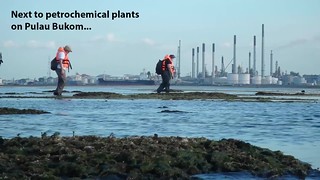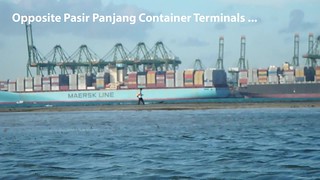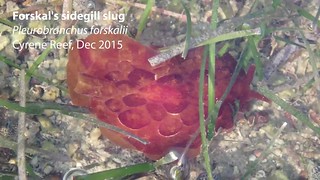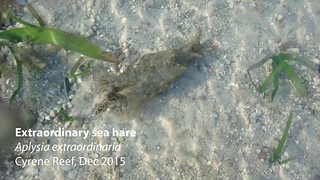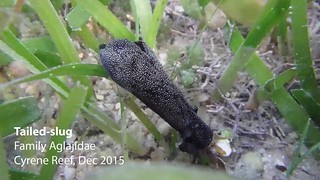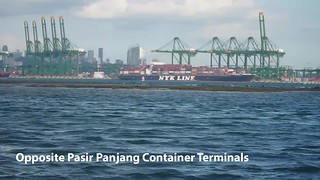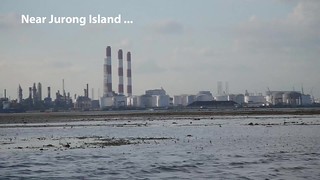The weather was awesome, company great as usual. What a lovely way to end the year.
Cyrene lies in the middle of the industrial triangle made up of the massive industries on Jurong Island, huge refineries on Pulau Bukom and the world-class container terminals at Pasir Panjang.
Despite its location, Cyrene Reef is full of amazing marine life. Among the most spectacular are the large Knobbly sea stars which are everywhere at our landing site.
On our trip Forskal's sidegill slugs were super abundant among the seagrass meadows just off Pasir Panjang Container Terminal.
This group of slugs got their name because they have one plume-like gill on one side of the body. I noticed those slugs that were out of water at low tide exposed this gill. To keep themselves cool?
Sidegill slugs are carnivorous and have strong jaws with a broad radula (ribbon of tiny teeth). Most feed on sponges, some also feed on hard corals and ascidians. Some even eat other slugs and fishes. We don't know what the Forskal's sidegill slugs eat. But it appears the slugs are eaten by sea turtles!
I only realised later that there were two of these slugs next to one another. The bigger one above the sand wasn't moving and jammed up next to it was a smaller one that was half buried in the sand (yellow circle). Are they mating? Sidegill slugs are hermaphrodites like most other slugs, each slug having both male and female reproductive organs. When they mate, they exchange sperm.
Among the seagrasses I saw some white egg ribbons that were probably laid by the slugs.
I also saw the Extraordinary sea hare. Sea hares have a pair of 'wings' or flaps (called parapodia). Some sea hares can swim by flapping their parapodia. Most sea hares have a shell, but this is reduced, thin and just under the skin.
We often see many and different kinds of Tailed slugs at Cyrene. Some tailed slugs are carnivores and eat their prey whole, crushing them with hard calcareous plates in the gizzard. Their prey include other slugs, flatworms, acoel flatworms and polychaete worms. Some have well developed structures to track down their prey by following the prey's mucous trail. Others are herbivores.
Among the special finds for me was this snail that I've not seen before. It was on the sand and it was burrowing. I don't know what it is.
Cyrene's broad sand bars have rarey snails like the Grey bonnet snail and Eggwhite moon snail that we rarely see on other shores.
Cyrene has among the best seagrass meadows in Singapore. And these teem with marine life. Here's a clip of some commonly seen creatures.
How are the seagrasses doing at Cyrene?
I dread checking out the deep pool where Tape seagrasses used to be so lush that NParks could conduct regular surveys of the rarey fishes that live there. In 2010, the seagrasses drastically declined (together with general loss all over Cyrene) and the pool turned into a sandy one with hardly any seagrass. Finally, five years later, on this trip I was so relieved to see much more seagrasses growing in the deep pool.
Here's a look at the deep pool over the years, at its best and its sudden death. This is what the pool looked like in Jun 2009, with Jeff and Collin of NParks doing a survey of the abundant variety of fishesfound in the pool.
Aug 2010: The pool is still full of lush long Tape seagrass. In this photo, an NPark's team is gently doing a survey of the fishes that are found in the pool. More in this blog post.
May 2010: NParks continued their fish survey and found many different kinds here.

May 2012: It turned into a rather clear pool with the white sandy base showing, and no long Tape seagrasses. Although the Tape seagrasses are still there (but short) and there are some other kinds of seagrasses growing at the bottom, and especially at the shallower edges.
Mar 2012: The big pool which used to be full of long lush Tape seagrass remains bare of Tape seagrasses. But other seagrass species are growing on the sandy bottom.
Aug 2012: There are still lots of seagrasses at the edges of the pool. But in the deeper part of pool, it's very bare of seagrasses. Tape seagrasses here are still cropped short, with not much of other kinds of seagrasses.
Apr 2013: We checked the pool in the middle of the Reef and it's still rather bare. Although there are other kinds of seagrasses especially around the shallower edges, the Tape seagrasses here are still very short, even in deeper parts of the pool.
Aug 2015: Finally, five years later, on this trip I was so relieved to see much more seagrasses growing in the deep pool.

This is what the pool looks like now (Dec 2015)! Hopefully, Tape seagrasses here will recover to their full length soon!
Here's a video of the seagrasses growing in the deep pool.
It was a relief to see long Tape seagrasses both in seagrassy areas as well as more sandy areas. There were good growths of all the species of seagrasses seen here. Including Smooth ribbon seagrass.
I suspect the seagrasses are recovering because the massive reclamations nearby that have been going on for years have finally come to an end. For example, this is what the new Pasir Panjang Container Terminal extension looks like on our trip.
The Terminal is already in operation, the site no longer has huge heaps of uncovered sand.
This is what the Pasir Panjang Container Terminal extension looked like in Jan 2012 when I joined an NParks team to survey for impact of an oil spill.

On that same trip, I also noticed reclamation going on at Jurong Island.
Let's hope there will be no more massive reclamations near our Southern shores in the future.
It's only possible to visit Cyrene (and our many other submerged reefs) with the support and care of Alex and his crew at Summit Marine.
There are few low spring tides early in the new year. So we will get to rest for a bit before the crazy predawn trips start in 2016.
Photos by others on this trip
- Juria Toramae on facebook.
- Russel Low on facebook.
- Loh Kok Sheng on his blog.
- Marcus Ng and Nicole Wong on facebook.
- Richard Kuah on facebook.
- Chay Hoon on facebook.



